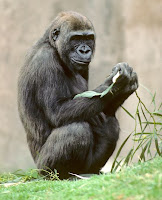Gorilla genome sheds new light on human evolution
(Reuters) Scientists have sequenced the genome of the gorilla, the last great ape to have its genes decoded, and say it gives new insights into differences between the apes and humans -- including their ability to produce competitive sperm.
While confirming that our closest relative is the chimpanzee, the research also shows that around 15 percent of the human gene map resembles the gorilla more closely than it does the chimpanzee genome.
Chris Tyler-Smith, who worked with a team of scientists who presented their findings in a telephone briefing, said that while many human genes are similar to the gorilla versions, it is the ones that differ that are often most intriguing.
One difference that stuck out was in the genes involved in sperm production, he said.
"Gorillas live in groups with one male and lots of females, so there's not much opportunity for sperm competition," he explained. "It was interesting for us to see that some genes involved in sperm formation...had either become inactive in gorillas or had decreased in copy number."
The study was published in the journal Nature on Wednesday.
Gorillas survive in just a few isolated and endangered populations in the equatorial forests of central Africa. There are two distinct species, one known as the eastern lowland and mountain gorillas, and the other known as western lowland and cross river gorillas.
The team used DNA from a western lowland gorilla, named Kamilah, to assemble a gorilla genome sequence and then compared it with the gene maps of the other great apes.
They also sampled DNA sequences from other gorillas so they could explore genetic differences between gorilla species.
"The gorilla genome is important because it tells us about that crucial time when we were diverging from our closest evolutionary cousins," said Aylwyn Scally of Britain's Wellcome Trust Sanger Institute, who led the research team.
The human genome project was completed in 2003, while the chimpanzee gene map was published in 2005 and the orangutan genome was completed in 2011.
"Comparisons between these can help us explore the origins of humans when we separated from the great ape species in Africa between 6 and 10 million years ago," said Richard Durbin, who also worked on the study at the Sanger Institute.
The team searched more than 11,000 genes in human, chimpanzee and gorilla for genetic changes important in evolution. They found as expected that humans and chimpanzees are genetically closest to each other over most of the genome, but they found many places where this is not the case.
In all three species, genes relating to sensory perception, hearing and brain development showed accelerated evolution, the researchers said, particularly in humans and gorillas.
The team found that divergence of gorillas from humans and chimpanzees happened around ten million years ago, but the split between eastern and western gorillas was much more recent and more gradual. They compared this split to the one between chimpanzees and bonobos, or modern humans and Neanderthals.
(Reuters) Scientists have sequenced the genome of the gorilla, the last great ape to have its genes decoded, and say it gives new insights into differences between the apes and humans -- including their ability to produce competitive sperm.
While confirming that our closest relative is the chimpanzee, the research also shows that around 15 percent of the human gene map resembles the gorilla more closely than it does the chimpanzee genome.
Chris Tyler-Smith, who worked with a team of scientists who presented their findings in a telephone briefing, said that while many human genes are similar to the gorilla versions, it is the ones that differ that are often most intriguing.
One difference that stuck out was in the genes involved in sperm production, he said.
"Gorillas live in groups with one male and lots of females, so there's not much opportunity for sperm competition," he explained. "It was interesting for us to see that some genes involved in sperm formation...had either become inactive in gorillas or had decreased in copy number."
The study was published in the journal Nature on Wednesday.
Gorillas survive in just a few isolated and endangered populations in the equatorial forests of central Africa. There are two distinct species, one known as the eastern lowland and mountain gorillas, and the other known as western lowland and cross river gorillas.
The team used DNA from a western lowland gorilla, named Kamilah, to assemble a gorilla genome sequence and then compared it with the gene maps of the other great apes.
They also sampled DNA sequences from other gorillas so they could explore genetic differences between gorilla species.
"The gorilla genome is important because it tells us about that crucial time when we were diverging from our closest evolutionary cousins," said Aylwyn Scally of Britain's Wellcome Trust Sanger Institute, who led the research team.
The human genome project was completed in 2003, while the chimpanzee gene map was published in 2005 and the orangutan genome was completed in 2011.
"Comparisons between these can help us explore the origins of humans when we separated from the great ape species in Africa between 6 and 10 million years ago," said Richard Durbin, who also worked on the study at the Sanger Institute.
The team searched more than 11,000 genes in human, chimpanzee and gorilla for genetic changes important in evolution. They found as expected that humans and chimpanzees are genetically closest to each other over most of the genome, but they found many places where this is not the case.
In all three species, genes relating to sensory perception, hearing and brain development showed accelerated evolution, the researchers said, particularly in humans and gorillas.
The team found that divergence of gorillas from humans and chimpanzees happened around ten million years ago, but the split between eastern and western gorillas was much more recent and more gradual. They compared this split to the one between chimpanzees and bonobos, or modern humans and Neanderthals.



Comments
Post a Comment